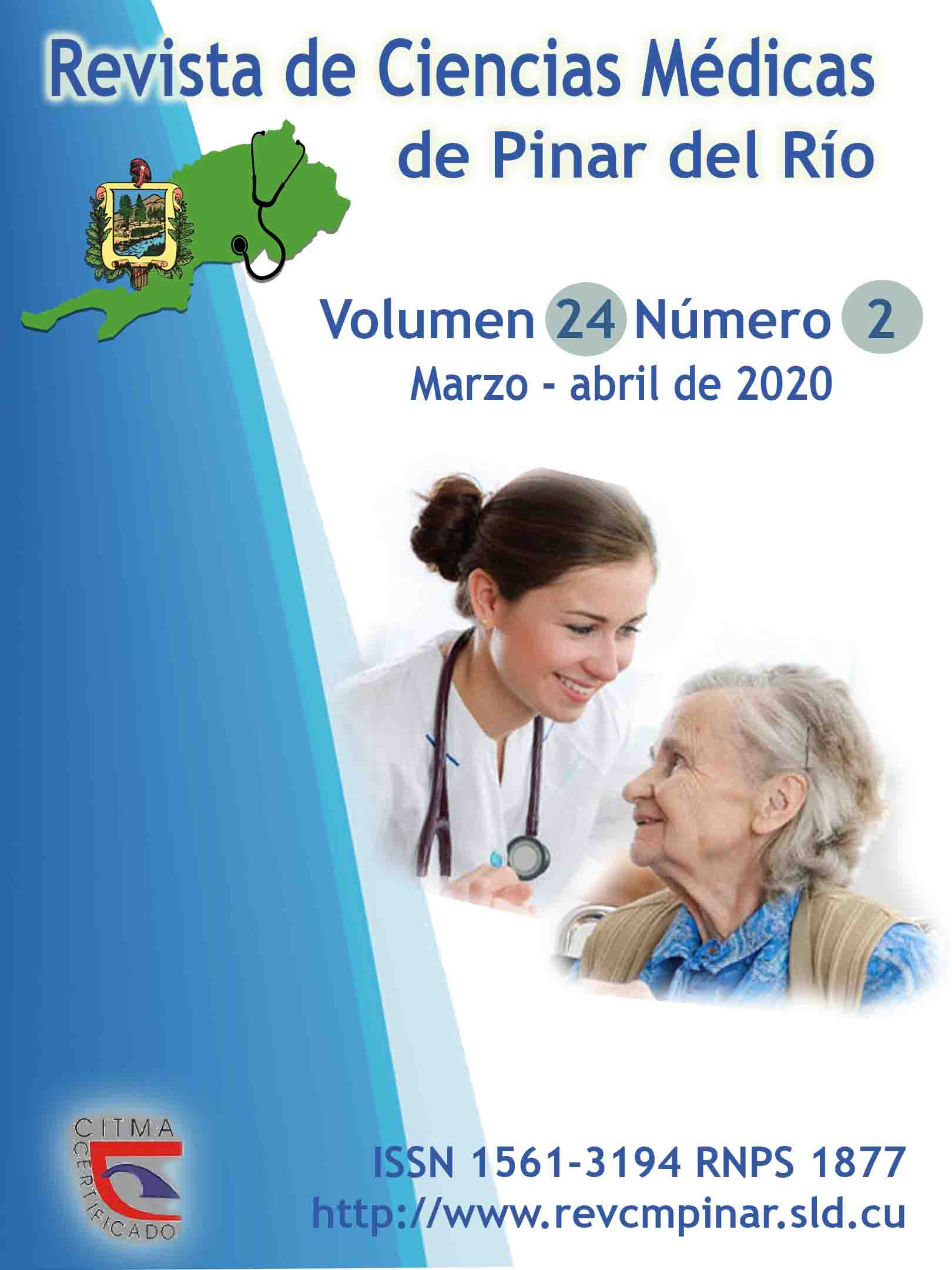Program for the prevention of sickle cell anemia: a preventive strategy
Keywords:
ANEMIA DE CÉLULAS FALCIFORMES, ELECTROFORESIS, ASESORAMIENTO GENÉTICO.Abstract
Introduction: hemoglobinopathies, including sickle cell disease, are the most frequent monogenic alterations in the world, with an autosomal recessive inheritance pattern. In Cuba, it is the most frequent molecular disease. The Program for the Prevention of Hemoglobinopathies is based on research through the study of hemoglobin electrophoresis in all pregnant women and has been applied in Cuba since 1983.
Objective: to design a preventive educational strategy for couples at risk based on the results of the program for the prevention of hemoglobinopathies in Pinar del Río province during the period of 2013-2018.
Methods: a descriptive, retrospective and longitudinal study was carried out with all pregnant women who had undergone hemoglobin electrophoresis during 2013-2018, along with those whose condition was known from previous pregnancies. The percentage of carriers was calculated, as well as the homozygous for S and C allele, to all these cases the couple was studied. The results were presented in tables.
Results: the frequency of carriers of hemoglobin S and C was 1.49 % and 0.30 % respectively, 95.1 % of the spouses were studied, there were 34 couples at risk who underwent fetal molecular study, after genetic counseling.
Conclusions: genetic counseling and fetal molecular study were provided to high-risk couples, corroborating the need to improve the education of the population regarding this disease.
Downloads
References
1. González García R, Maza Blanes MA, Oliva López Y, Menéndez García R. Resultados del programa de prevención de hemoglobinopatías SS y SC. Rev. Ciencias Médicas [Internet]. 2013 [citado 12/04/2018]; 17(4): [aprox. 10p.]. Disponible en: http://scielo.sld.cu/pdf/rpr/v17n4/rpr06413.pdf
2. González García R, Miranda Cañedo I, Álvarez Pita J. Electroforesis de hemoglobina en hijos de madres portadoras de hemoglobinopatías SS y SC. Rev. Ciencias Médicas [Internet]. 2018 [citado 12/04/2018]; 22(1): [aprox. 7p.]. Disponible en:http://www.revcmpinar.sld.cu/index.php/publicaciones/article/download/3262/pdf
3. Kato GJ, Piel FB, Reid CD, Gaston MH, Ohene-Frempong K, Krishnamurti L, et al. Sickle cell disease. Nature Reviews Disease Primers [Internet]. 2018 [citado 12/04/2018];
4(18010): [aprox. 15p.]. Disponible en: https://www.nature.com/articles/nrdp201810.pdf
4.Valdes Fraser Y, Pérez Rodríguez J, Fuentes Cortes I, Gámez Torres G, Concepción Álvarez A, Suárez Besil B. Resultados del Programa de Prevención de Anemia Falciforme en el Centro Nacional de Genética Médica de Cuba (2008-2014). Rev Cubana Genet Comunit [Internet]. 2016 [citado 12/04/2018]; 10(1): [aprox. 5p.]. Disponible en: http://www.bvs.sld.cu/revistas/rcgc/v10n1/060116.pdf
5. Campos Cuevas N, Ruiz Juan Y, Calvo Díaz MM, Évora Gournalusse T, Raymond Lobaina H, Abad Lobaina TL. Evaluación del programa de prevención de anemias por hematíes falciformes desde 1989 a 2013 en Guantánamo. Rev Inf Cient [Internet]. 2015 [citado 12/04/2018]; 89(1): [aprox. 10p.]. Disponible en: http://www.revinfcientifica.sld.cu/index.php/ric/article/download/266/1018
6. Zavala GL, Viera W, Castillo GE, Gustavo E, Mejía GE, Bustillo PL, et al. Prevalencia de anemia drepanocitica en población de la comunidad de san juan, Yoro. Rev. Fac. Cienc. Méd. [Internet] Enero - Junio 2014 [citado 12/04/2018]; 11(1): [aprox. 8p.]. Disponible en: http://www.bvs.hn/RFCM/pdf/2014/pdf/RFCMVol11-1-2014-4.pdf
7. Turró Crespo A, García Guerra Y, Saavedra Moragas I. Resultados del programa cubano de prevención de anemia falciforme en la Isla de la Juventud. 2008-2012. REMIJ [Internet]. 2013 [citado 12/04/2018]; 14(2): [aprox. 18p.]. Disponible en: http://remij.sld.cu/index.php/remij/article/view/71/149
8. Ayala Viloria Alfonso J, González Torres Henry J, David Tarud Gabriel J. Anemia de células falciformes: una revisión. Revista Científica Salud Uninorte. [Internet]. 2016 [citado 18/04/2018]; 32(3): [aprox. 14p.]. Disponible en: http://www.bloodjournal.org/content/bloodjournal/127/7/789.full.pdf?sso-checked=true
9. Nussbaum RL, Mclnnes RR, Willard HF. En Thompson and Thompson Genética en Medicina. 7ma ed. España: Editorial Elsevier Masson; 2008.p.321-27.
10. Escobar Pérez D, Reyes Reyes E, Orive Rodríguez NM, Pacheco Torres Y. Hemoglobinopatías en gestantes y parejas de riesgo de Las Tunas. Revista Electrónica Dr. Zoilo E. Marinello Vidaurreta [Internet]. 2017 [citado 12/04/2018]; 42(2): [aprox. 7p.]. Disponible en: http://revzoilomarinello.sld.cu/index.php/zmv/article/view/1043/pdf_386
11. Mueller RF, Young ID. Genética y anomalías congénitas. En: Emery´s Genética Médica. 10ma ed. Madrid: Marbán; 2001. p143-44.
12. Guerra Batista VS, Pérez Breff G, Pérez Delgado MC, Pérez Sánchez S, Frías Fernández MM. Resultados del programa de detección precoz de la anemia por hematíes falciformes en Mayarí durante 2002–2012. CCM [Internet]. 2015 [citado 12/04/2018]; 19(4): [aprox. 10p.]. Disponible en: http://scielo.sld.cu/pdf/ccm/v19n4/ccm02415.pdf
13. Taboada Lugo N, Gómez Rojo M, Algora Hernández AE, Arcas Ermeso G, Noa Machado MD, Herrera Martínez M. Pesquisaje prenatal de Hemoglobinopatías SS y CC: 25 años de experiencia en la provincia Villa Clara, Cuba. Revista de Salud [Internet]. 2015 [citado 12/04/2018]; 10(24): [aprox. 9p.]. Disponible en: http://www.revistasbolivianas.org.bo/pdf/riis/v10n24/v10n24_a06.pdf
14. Pujadas Rios X, Viñals Rodríguez LL. Enfermedad de células falciformes en el embarazo. Rev Cubana Obstet Ginecol [Internet]. 2016 [citado 12/04/2018]; 42(2): [aprox. 15p.]. Disponible en: http://scielo.sld.cu/pdf/gin/v42n2/gin10216.pdf
Downloads
Published
How to Cite
Issue
Section
License
Authors who have publications with this journal agree to the following terms: Authors will retain their copyrights and grant the journal the right of first publication of their work, which will be publication of their work, which will be simultaneously subject to the Creative Commons Attribution License (CC-BY-NC 4.0) that allows third parties to share the work as long as its author and first publication in this journal are indicated.
Authors may adopt other non-exclusive license agreements for distribution of the published version of the work (e.g.: deposit it in an institutional telematic archive or publish it in a volume). Likewise, and according to the recommendations of the Medical Sciences Editorial (ECIMED), authors must declare in each article their contribution according to the CRediT taxonomy (contributor roles). This taxonomy includes 14 roles, which can be used to represent the tasks typically performed by contributors in scientific academic production. It should be consulted in monograph) whenever initial publication in this journal is indicated. Authors are allowed and encouraged to disseminate their work through the Internet (e.g., in institutional telematic archives or on their web page) before and during the submission process, which may produce interesting exchanges and increase citations of the published work. (See The effect of open access). https://casrai.org/credit/



